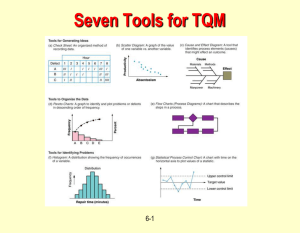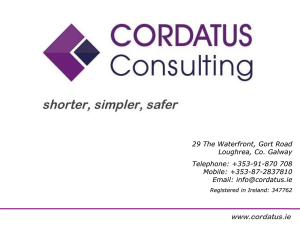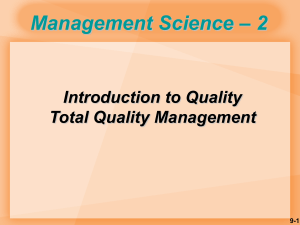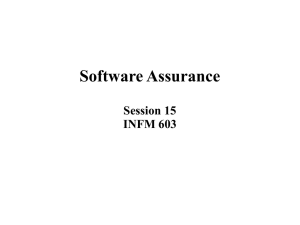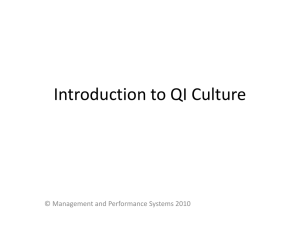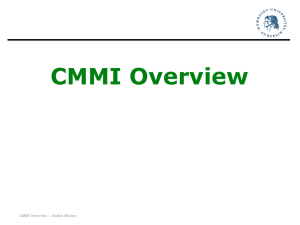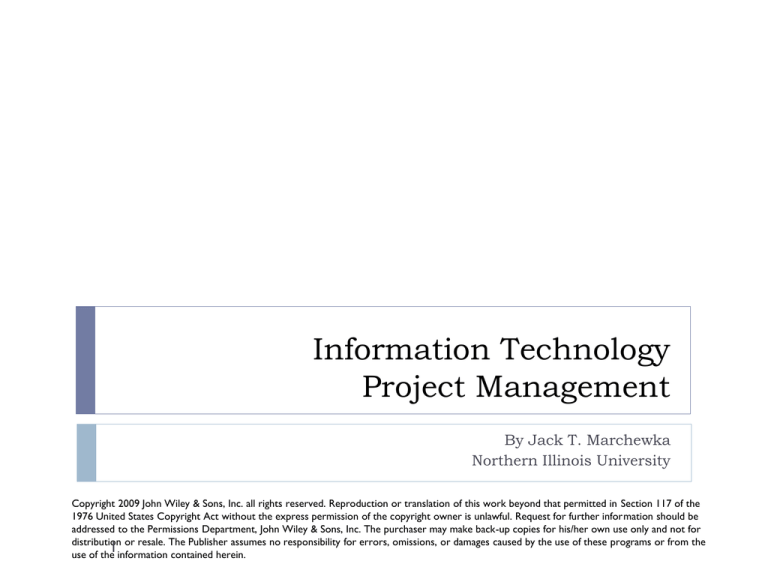
Information Technology
Project Management
By Jack T. Marchewka
Northern Illinois University
Copyright 2009 John Wiley & Sons, Inc. all rights reserved. Reproduction or translation of this work beyond that permitted in Section 117 of the
1976 United States Copyright Act without the express permission of the copyright owner is unlawful. Request for further information should be
addressed to the Permissions Department, John Wiley & Sons, Inc. The purchaser may make back-up copies for his/her own use only and not for
distribution or resale. The Publisher assumes no responsibility for errors, omissions, or damages caused by the use of these programs or from the
1
use of the information contained herein.
IT Project Quality Management
Chapter 10
2
What is Quality?
“an inherent or distinguishing characteristic; a property;
having a high degree of excellence”
What makes a car a quality car - number of features,
reliability, features, safety, affordability, high price?
Features & functionality – is that enough to define quality
Business defines quality as
“fitness for use” – meets the customer’s needs
“conformance to requirements” - meets a predefined set of
standards
Quality depends on the needs or expectations of the
customer
The PM and team must define accurately those needs while staying
within resource constraints
3
PMBOK® – Project Quality Management
(PQM)
PQM processes include all of the activities of the
performing organization that determine quality policies,
objectives, and responsibilities so that the project will
satisfy the needs for which it was undertaken.
It implements the quality management system through
the policy procedures and processes of quality planning,
quality assurance, and quality control with continuous
process improvement activities conducted throughout, as
appropriate.
4
PMBOK® – PQM Processes
Quality planning
Determining which quality standards are important to the project
and deciding how these standards will be met.
Quality assurance
Evaluating overall project performance regularly to ensure that the
project team is meeting the specified quality standards.
Quality control
Monitoring the activities and results of the project to ensure that the
project complies with the quality standards. In addition, the project
organization as a whole should use this information to eliminate
causes of unsatisfactory performance and implement new processes
and techniques to improve project quality throughout the project
organization.
5
PQM Focuses on
The project’s products
Business Case
Project Plan
The IT Solution
Etc.
And the project’s processes
Scope management
Risk management
Requirements Analysis
Design
Implementation
Etc.
6
The Quality Chain
More efficient & effective use of resources
Minimize errors
Meet or exceed stakeholder expectations
More rework, waste, & errors
Negative impact on project goal &
objectives
Poor quality can be an embarrassment!
Project and IT development processes support the project’s products
Customers may be internal or external
7
Project Quality Management
ISO, Six Sigma,CMM,
Deming, Baldrige
Code and document
management of
multiple versions of
files and documents
Are we building the
right product? Are we
building the product
the right way?
Continuous
improvement and
maturing IT project
management
processes
8
Quality Tools & Philosophies
Scientific Management
Control Charts
The Total Quality Movement (TQM)
Quality Planning, Improvement, & Control
Cause & Effect Diagrams, Pareto Charts, and Flow
Charts
9
Scientific Management
Fredrick W. Taylor (1856 – 1915)
Management would set arbitrary rules of thumb which
restricted output
Workers produced so much each day – no more, no less.
Produced too much, pay rate changed
Believed the production process could be more efficient
Break
a task down into smaller tasks & study it to find the best
and most efficient way of doing it. Removed variability and
errors.
Time – motion studies
Did not sit well with labor unions because many ignored the
human factors & believed profits could be increased by
speeding up the workers
Taylor later acknowledged that motivation can affect
output more than just engineered improvements
10
Control Charts
Walter A. Shewhart (1891 – 1967)
Worked for Western Electric Company (Bell Telephones)
Quality improvements needed for underground
equipment
Applied statistical theory to control production processes
Introduced the control chart to understand variation
and allow management to shift focus away from inspection
(reactive) and more toward the prevention of problems
and the improvement of processes (proactive)
11
Control Charts
Provides a picture of how a particular process is behaving over
time
Center
line – observed average (mean)
Control limits on both sides provide a measure of variability
Generally set at ±3σ (σ: population standard deviation) or
±3s (s : sample standard deviation)
If the process is normally distributed, control limits on 3 std dev provides
.001 probability limits
Variation
due to common (chance) causes is considered
normal, result of normal interactions among the components of
the process
People, machines, material, environment
and methods
Will remain stable and exhibit a consistent pattern over time
Variation will be random and vary within predictable bounds (one
out of a thousand that an observation will exceed bounds)
12
Control Charts
Any
observation that falls outside the control limits could be
attributed to an assignable cause
Due
to phenomena not considered part of the normal process
Changes in raw material, poorly trained people, machine failures,
changes in the work environment
Process is stable or in
statistical control
Assignable cause
variation
13
Control Charts
Tests for detecting non-random patterns in control charts
A single point falls outside the 3σ control limits
Look for patterns that suggest that the observed data is not
statistically independent. A process may not be in control if:
At
least two or three successive values that fall on the same side of
and more than two standard deviation from the centerline
At least four out of five successive values that fall on the same side of
and more than one standard deviation away from the centerline
At least eight successive values that fall on the same side of the
centerline
Control charts are a valuable tool but keep in mind that one
can see patterns where patterns may not exist
14
The Total Quality Movement
W. Edwards Deming (1900 – 1993)
Worked with Shewhart at Western Electric
Hawthorne Plant in Chicago, IL in the 1920s
Management treated the worker as a cog in the
machinery
Final inspection used to control quality
Worker
not directly responsible
Scrap & rework reduced per piece rate
Deming realized that costly inspections could be
eliminated if workers were properly trained and
empowered to monitor and control the quality of the
items they produced
15
The Total Quality Movement
His teachings were relatively unnoticed in the US but
Japan, in a rebuilding stage after WWII, was looking to
improve their industry
Japan
had few natural resources so the quality of their
goods was key to a good economy
Invited to give series of day-long lectures to managers in
Japan in the 1950s
Japan embraced his quality methodology and named
their most prestigious quality award the Deming Prize
In 1980, an NBC documentary entitled If Japan Can, Why
Can’t We introduced him and his ideas to the US and the
rest of the world
16
Deming’s 14 Points
1.
2.
3.
4.
5.
6.
7.
8.
9.
10.
11.
12.
13.
14.
Create constancy of purpose toward improvement of products and
services with the aim to become competitive, stay in business, and provide
jobs.
Adopt the new philosophy of management.
Don’t depend on inspection at the end.
Don’t award business based on price tag.
Keep improving constantly.
Institute training on the job.
Institute leadership.
Drive out fear.
Break down barriers between departments.
Eliminate slogans.
a) Eliminate quotas.
b) Eliminate management by objective and by numbers.
Take pride in your work.
Focus education and self-improvement.
It takes everyone to accomplish the transformation.
From Out of the Crisis by W. Edwards Deming (1986)
Also see http://www.managementwisdom.com/freilofdem14.html
17
Quality Planning, Improvement, & Control
Joseph Juran (1904 - 2007)
His book, Quality Control Handbook, viewed quality as
“fitness for use” as perceived by the customer
Also invited to Japan to conduct seminars in the 1950s
Message is that quality does not happen by accident – it
must be planned in
Juran’s view of quality
The quality trilogy – planning, control and improvement –
combined with the steps of Juran’s Quality Planning Road Map
His work in quality management led to the development of the
widely practiced business methodologies referred to as Six Sigma
and lean manufacturing.
18
Quality Planning, Improvement, & Control
Juran’s Quality Planning Road Map (Quality Trilogy)
Quality Planning
1. Identify who are the customers.
2. Determine the needs of those customers.
3. Translate those needs into our language.
4. Develop a product that can respond to those needs.
5. Optimize the product features so as to meet our needs as well as customer
needs.
Quality Improvement
6. Develop a process that is able to produce the product.
7. Optimize the process.
Quality Control
8. Prove that the process can produce the product under operating conditions.
9. Transfer the process to Operations.
19
Cause & Effect Diagrams, Pareto Charts
and Flow Charts
Kaoru Ishikawa (1915 - 1989)
Studied under Deming
Believed quality is a continuous process that
relies on all levels of the organization
In Japan, this led to the use of quality circles that
engaged all members of the organization
20
Cause & Effect Diagrams, Pareto Charts
and Flow Charts
Advocated
the use of easy-to-use
statistical tools
Ishikawa, or
Fishbone Diagram
Identify
major causes and sub-causes of a problem
from which solutions can arise
21
Ishikawa, or Fishbone Diagram
22
Cause & Effect Diagrams, Pareto Charts
and Flow Charts
Pareto
Diagram
Alfred
Pareto (1848-1923) studied the distribution
of wealth in Europe and found that about 80% of the
wealth was owned by 20% of the population – 80/20
rule
Managers use this technique to help them separate
the “vital few” resources from the “useful many.”
Pareto diagram constructed by classifying and
ranking data and then summarizing from largest to
smallest
Helps identify major issues or causes of a problem
and provides potential solutions
23
Pareto Chart
24
Cause & Effect Diagrams, Pareto Charts
and Flow Charts
Flow
Charts
Useful
for documenting a specific process in
order to understand how products or
services move through various functions or
operations
Helps visualize a particular process and
indentify potential problems or bottlenecks
Flow chart to follow documents the projet
management process for verifying a project’s
scope
25
Flow Chart
for Project
Scope
Verification
26
Quality Systems
ISO
6 – Sigma
Capability Maturity Model
Copyright 2012 John Wiley & Sons, Inc.
10-27
Quality Systems - ISO
International Organization for Standardization (ISO)
Derived from Greek word “isos,” meaning “equal”
Formed in 1947 with delegates from 25 countries
Today has over 130 members “to facilitate the international
coordination and unification of industrial standards.”
Credit cards adhere to a standard size and thickness so
they can be used worldwide
Most standards are specific to a particular product, material
or process
28
Quality Systems - ISO
Generic management system standards - standards that
make up the ISO 9000 (organizations) and ISO 14000
(environmental) families
Can be applied to any size or type of organization in any
industry
ISO
9000 – focuses on quality management, improved
customer satisfaction and the continuous improvement of an
organization’s performance and processes
ISO 14000 – environmental management, how an organization
can minimize any harmful effects on the environments that may
be caused by its activities or operations
29
Quality Systems - ISO
ISO/IEC
15504 Information technology — Process
assessment, also known as SPICE (Software Process
Improvement and Capability Determination), is a set of
technical standards documents for the computer
software development process and related business
management functions.
Initially
was derived from process lifecycle standard
ISO/IEC 12207 and from maturity models like Bootstrap,
Trillium and the CMM.
30
Quality Systems - ISO
ISO 9001 – for organizations whose business processes
range from design through development, as well as
production, installation and service. For engineering and
software development
To become ISO certified, an organization conducts an
internal audit, corrects deficiencies and arranges a thirdparty registrar to audit the organization
The ISO does not conduct the audits or issue certificates
An organization does not have to have a formal registration or
certificate to be in compliance with ISO but customers are
more likely to believe it if an independent third-party attests
to it
31
Quality Systems - 6 Sigma
Resulted from competitive pressures by foreign firms that
were able to produce higher quality products at a lower cost
than Motorola
Motorola admitted “our quality stinks”
Sigma represents the standard deviation to measure variability
from the mean.Variation is often the cause of defects or outof-control processes and translates into products or services
that do not meet customer needs or expectations
If a manufacturing process follows a normal distribution, then the
mean and s.d. can be used to provide probabilities for how the
process can or should perform
32
Quality Systems - 6 Sigma
Focuses on defects per opportunities (DPO) as a basis for
measuring the quality of a process rather than products it
produces because products may vary in complexity
A defect is anything that results in a customer dissatisfaction
The sigma values tells us how often defects are likely to occur
Six Sigma can be viewed as a quality objective whereby
customer satisfaction will increase as a result of reducing
defects
It is also a business driven approach for improving processes,
reducing costs and increasing profits
May require a significant investment in training and infrastructure
33
Quality Systems - 6 Sigma
Sigma
Defects Per Million
1δ
690,000
2δ
308,537
3δ
66,807
4δ
6,210
5δ
233
6δ
3.4
34
Quality Systems - 6 Sigma
3δ
6δ
Five short or long landings at One short or long landing in
any major airport
10 years at all airports in the
US
Approximately 1,350 poorly One
incorrect
surgical
performed surgical operations operation in 20 years
in one week
Over 40,500 newborn babies Three
newborn
babies
dropped by doctors or nurses dropped by doctors or nurses
each year
in 100 years
Drinking water unsafe to drink Water unsafe to drink for one
for about 2 hours each month second every six years
35
Key Steps in the Six Sigma D-M-A-I-C Cycle
Define
Measure
With data in hand, the team can analyze the data for trends, patterns, or
relationships. Statistical analysis allows for testing hypotheses, modeling, or
conducting experiments.
Improve
The Six Sigma team is responsible for identifying a set of relevant metrics.
Analyze
The first step is to define customer satisfaction goals and subgoals; for example,
reduce cycle time, costs, or defects. These goals then provide a baseline or
benchmark for the process improvement.
Based on solid evidence, improvements can be proposed and implemented. The
Measure-Analyze-Improve steps are generally iterative to achieve target levels of
performance.
Control
Once target levels of performance are achieved, control methods and tools are put
into place in order to maintain performance.
36
6-Sigma Roles & Responsibilities
Master black belts
Black belts
Should be technically competent and held in high esteem by their peers. They are
actively involved in the Six Sigma change process.
Green belts
People within the organization who have the highest level of technical and
organizational experience and expertise. Master black belts train black.
Are Six Sigma team leaders or project managers. Black belts generally help green
belts choose their projects, attend training with them, and then assist them with
their projects once the project begins.
Champions
Leaders who are committed to the success of the Six Sigma project and can ensure
that barriers to the Six Sigma project are removed. Usually a high-level manager
who can remove obstacles that may involve funding, support, bureaucracy, or other
issues that black belts are unable to solve on their own.
37
The Capability Maturity Model Integration
(CMMI)
Developed by the Software Engineering Institute at Carnegie
Mellon University in 1986
Mitre Corporation and Watts Humphrey developed a
framework to assess and evaluate the capability of software
processes and their maturity
Called the Capability Maturity Model (CMM), but has evolved to the
CMMI which is not limited to a specific area but can be used across
different disciplines and improve processes across the organization
Includes CMM for software (SW-CMM), system engineering capability
model (SECM) and the integrated product development capability
model (IPD-CMM)
Provides a set of recommended practices that define key process areas
specific to software development and provides a path to achieve
38
excellence in s/w engineering and management
Immature Software Organization
Software processes are improvised
Or not followed!
Managers continually “fight fires”
No basis for judging quality
Schedules & budgets are usually exceeded
Functionality & quality often compromised to meet
schedules
39
Mature Software Organization
Has organization-wide ability to manage software
development
Software processes and roles of individuals are defined
explicitly and communicated to staff
Quality of each s/w process is monitored so that the
products and processes are predictable across different
projects
Processes are consistent with the way work gets done
Processes are updated when necessary based on experiences
Budgets and schedules are based on past projects so they are
more realistic and the project goals and objectives are more
likely to be achieved
Roles & responsibilities are well-defined
40
Other CMMI Concepts
Software process
A set of activities, methods, or practices and transformations used by people to
develop and maintain software and the deliverables associated with software projects.
Included are such things as project plans, design documents, code, test cases, user
manuals, and so forth.
Software process capability
The expected results that can be achieved by following a particular software process.
More specifically, the capability of an organization’s software processes provides a way
of predicting the outcomes that can be expected if the same software processes are
used from one software project to the next.
Software process performance
The actual results that are achieved by following a particular software process.
Therefore, the actual results achieved through software process performance can be
compared to the expected results achieved through software process capability.
Software process maturity
The extent to which a particular software process is explicitly and consistently
defined, managed, measured, controlled, and effectively used throughout the
organization.
41
Levels of Software Process Maturity
42
CMMI
Level 1: Initial
Characterized by an immature software
organization in which the software process is ad
hoc and often reactive to crises.
Does not have a stable environment for software
projects, and success of a project rests largely with
the people on the project and not the processes
that they follow.
Key Process Area
no key process areas are in place
43
CMMI
Level 2:
Repeatable - Basic policies, processes, and controls for managing a
software project are in place. Previous project successes can be
repeated by other project teams on other projects.
Key Process Area
Software Configuration Management
Software Quality Assurance
Software Subcontract Management
Software Project Tracking and Oversight
Software Project Planning
Requirements Management
44
CMMI
Level 3:
Defined - Software engineering and management processes are
documented and standardized throughout the organization and
become the organizations standard process.
A group is established to oversee the organization’s s/w processes and
an organization-wide training program to support the standard
process is implemented
The s/w process capability of this level is characterized as being
standard, consistent, stable and repeatable
Key Process Area
Peer Reviews
Intergroup Coordination
Software Product Engineering
Integrated Software Management
Training Programs
Organization Process Definition
Organization Process Focus
45
CMMI
Level 4:
Managed - Quantitative metrics for measuring and assessing
productivity and quality are established for both software
products and processes which are characterized as being
quantifiable and predictable.
Information stored in an organization-wide repository that can
analyze and evaluate s/w processes and products
Project performance controlled so that it falls within acceptable
control boundaries. Thus, s/w processes are quantifiable and
predictable
Key Process Areas
Software Quality Management
Quantitative Process Management
46
CMMI
Level 5:
Optimizing at the highest level of software process maturity
The whole organization is focused on continuous process
improvement.
Innovations using new technology and methods and incremental
process improvement
Organization has the ability to identify its areas of strengths and
weaknesses
Innovations and best practices based on lessons learned are identified
and disseminated throughout the organization
Key Process Areas
Process Change Management
Technology Change Management
Defect Prevention
47
CMMI
As an organization’s s/w process maturity increases, the
difference between expected results and actual results
narrows
Performance can be expected to improve when maturity
levels increase because costs and development time will
decrease while quality and productivity increase
48
The IT Project Quality Plan
There is no commonly accepted approach for PQM so
many project managers approach it differently
A basic framework will be introduced to integrate the
knowledge areas of quality planning, assurance, control and
improvement
49
Quality Philosophies & Principles
Focus on customer satisfaction
Prevention, not inspection – quality is built into the
product
Improve the process to improve the product
Quality is everyone’s responsibility; management must
provide resources, remove barriers and provide
leadership
Fact-based management – capture and analyze trends
about its processes to improve them
50
Developing Standards & Metrics
51
Project Quality Metrics
Process
Control the defects introduced by the processes required to create the
project deliverables
Can be used to improve software development or maintenance
Should focus on the effectiveness of identifying and removing defects or
bugs
Product
Focuses on the intrinsic quality of the deliverables and satisfaction of the
customer, client, or sponsor with these deliverables
Attempt to describe the characteristics of the project’s deliverables and
final product
Project
Focus on the control of the project management processes to ensure
that the project meets its overall goal as well as its scope, schedule, and
budget objectives
52
Process, Product & Project Metrics Examples
Type
Process
Product
Project
Metric
Description
Defect Arrival Rate
The number of defects found over a specific period of time.
Defects by Phase
The number of defects found during each phase of the project.
Defect Backlog
The number of defects waiting to be fixed.
Fix Response Time
The average time it takes to fix a defect.
Defective Fixes
The number of fixes that created new defects.
Mean Time to Failure
Average or mean time elapsed until a product fails.
Defect Density
The number of defects per lines of code (LOC) or function points.
Customer Found Defects
The number of defects found by the customer.
Customer Satisfaction
An index to measure customer satisfaction – e.g., scale from 1 (very unsatisfied)
to 5 (very satisfied)
Scope Change Requests
The number of scope changes requested by the client or sponsor.
Scope Change Approvals
The number of scope changes that were approved.
Overdue tasks
The number of tasks that were started but not finished by the expected date or
time.
Tasks that should have started
The number of task that should have started but have been delayed.
Over budgeted tasks
The number of tasks (and dollar amount) of tasks that have cost more to complete
than expected
Earned Value
Budgeted Cost of Work Performed (BCWP) – see Chapter 8.
Over allocated Resources
The number of resources assigned to more than one task.
Turnover
The number of project team members who quit or terminated.
Training Hours
The number of training hours per project team member.
53
Verification & Validation (V&V)
Verification Are we building the product the right way?
Focuses on process-related activities to ensure that the
products & deliverables meet specified requirements
before final testing
Technical Reviews – ensures that the IT solution conforms
to specified requirements
Walk-through
programmer/designer leads a group of his peers
through a program or technical design
Inspection – checklist to identify errors
Business Reviews – ensure that the deliverable is complete,
provides info needed for next phase, meets standards and
project methodology
Management Reviews – actual vs baseline comparison 54
Verification & Validation (V&V)
Validation Did we build the right product?
Product-oriented activities that attempt to
determine if the system or project deliverables
meet the customer or client’s expectations
Testing
Does the system function as intended and have all
the capabilities & features defined in the project’s
scope and requirements definition
Test plan should outline what is to be tested
Quality before design and cosing
55
Software Testing Approaches
Unit Testing
Focuses on the module, program, or object level to determine whether
specific functions work properly.
•Black Box Testing – Tests the program against specified requirements or
functionality.
•White Box Testing – Examines paths of logic or the structure inside a
program.
•Gray Box Testing – Focuses on the internal structure of the program.
Integration
Testing
Tests whether a set of logically related units (e.g., functions, modules,
programs, etc.) work together properly after unit testing is complete.
Systems
Testing
Tests the system as a whole in an operating environment to verify
functionality and fitness for use. May include tests to verify usability,
performance, stress, compatibility, and documentation.
Acceptance
Testing
Certifies that the system satisfies the end user or customer’s scope and
detailed requirements after systems testing is complete. It is the user’s or
client’s responsibility to assure that all features and functionality are
56
included so that the project’s MOV will be achieved.
Change, Control &
Configuration Management
Changes to the project work must be managed
What changes were made?
Who made the changes?
When were the changes made?
Why were the changes made?
Configuration management includes a set of processes and
tools that allow the project team to manage its various
documents and files as various configurations of IT solutions
and project deliverables are derived.
It may include specifying and enforcing various policies that restrict
access to specific individuals or preventing two people from changing
the same document or file at the same time – version control
57
Monitor and Control
Monitor project’s standards to ensure that the project quality
objective is achieved
Control is necessary for identifying problems in order to take
corrective action and make improvements once a process is under
control
Quality Control Activities should focus on the inputs and outputs of
each process.
Quality Control Tools – Ishikawa diagram, control chart, Pareto
diagram, checklist, run chart and project management tools
58
Learn, Mature, and Improve
Lessons learned
Provide the basis for continual improvement
Can be the basis for identifying and implementing best
practices
A quality plan should do more that attempt to build a
better IT solution, it should also support the
organization in searching for ways to manage
projects better.
59
Quality Decisions
60

